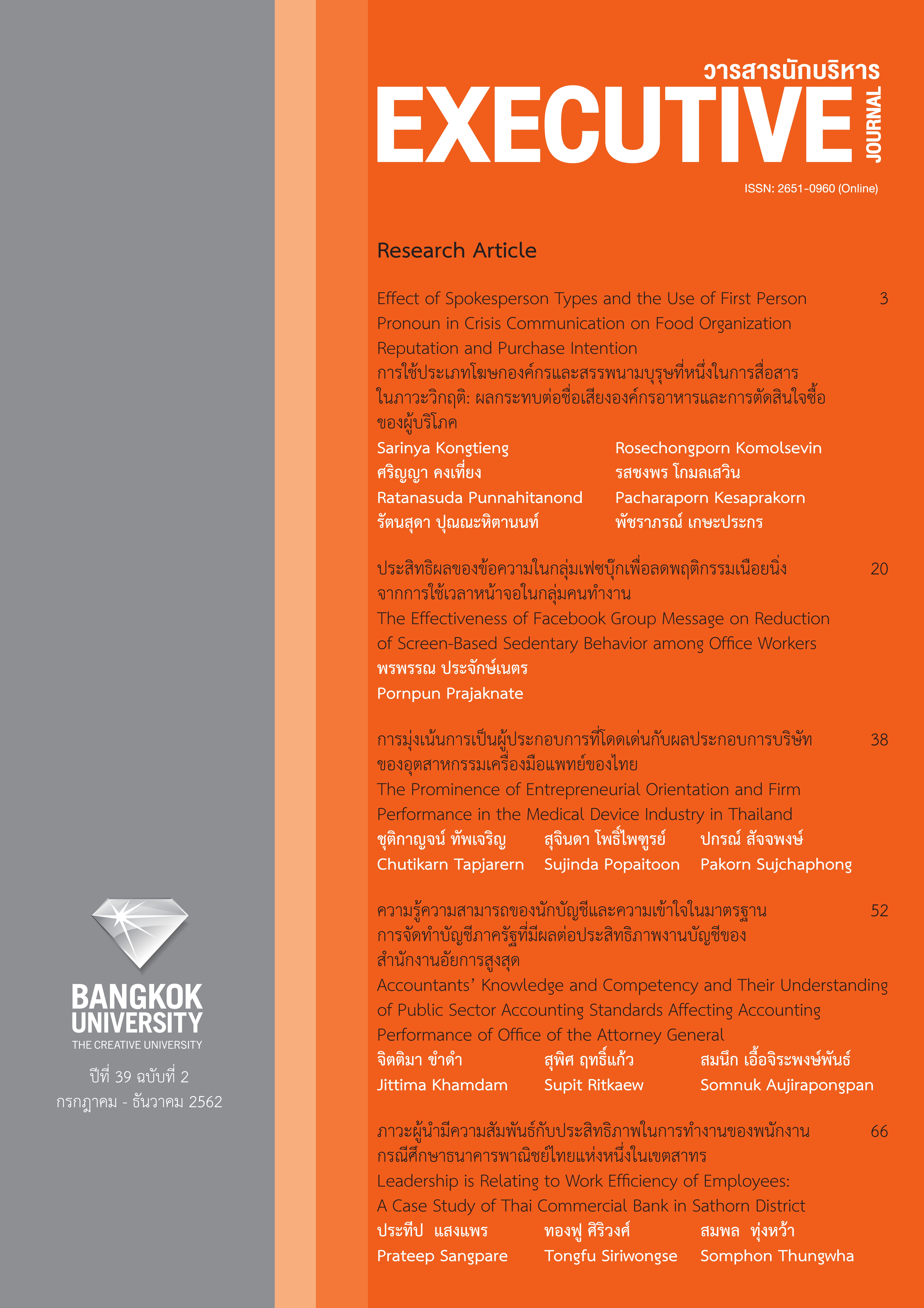เรียนรู้วิกฤตเศรษฐกิจ: การเข้าใจธรรมชาติของพฤติกรรมมนุษย์ ความเสี่ยงและโอกาสในการลงทุน เพื่อผลตอบแทนที่ยั่งยืน
Main Article Content
บทคัดย่อ
ความรู้ความเข้าใจเป้าหมายเป็นสิ่งสำคัญในการลงทุนเพื่อให้เกิดผลลัพธ์ที่น่าพึงพอใจของนักลงทุนเมื่อดำเนินกระบวนการอย่างมีสติ ธรรมชาติของมนุษย์มีอคติในการตัดสินใจ ดังนั้น แทนที่จะกล่าวโทษโชคชะตา นักลงทุนควรเรียนรู้จากความผิดพลาดและปรับการลงทุนให้มีประสิทธิภาพมากยิ่งขึ้น บทความนี้จะกล่าวถึงประวัติศาสตร์ของวิกฤติเศรษฐกิจ จิตวิทยาการลงทุน และการใช้กระบวนการลงทุน ตลอดจนความเข้าใจการเปลี่ยนแปลงของสถานการณ์ปัจจุบันเพื่อบรรลุเป้าหมายการลงทุนในสถานการณ์ปัจจุบันที่ตลาดทุนมีความผันผวนมากขึ้น เมื่อเทคโนโลยี สังคม และเศรษฐกิจ มีการเปลี่ยนแปลงอย่างรวดเร็ว นักลงทุนต้องวางเป้าหมายการลงทุน เข้าใจพฤติกรรมมนุษย์และตลาดทุน ควบคู่ไปกับการประเมินอัตราความเสี่ยงที่ยอมรับได้ และสามารถรับมือกับการเปลี่ยนแปลงได้อย่างมีประสิทธิภาพ ทั้งนี้ ความรู้ และการเรียนรู้บทเรียนจากหายนะทางเศรษฐกิจจะทำให้เราเข้าใจ และมีสติในการเห็นคุณค่าและบรรลุเป้าหมายได้ดีมากยิ่งขึ้น
Article Details
บทความที่นำมาสมัครลงตีพิมพ์ในวารสารต้องไม่เคยได้รับการตีพิมพ์เผยแพร่มาก่อน และไม่ส่งต้นฉบับบทความซ้ำซ้อนกับวารสารอื่น รวมทั้งผู้เขียนบทความต้องไม่ละเมิดหรือคัดลอกผลงานของผู้อื่น
เอกสารอ้างอิง
Acharya, V. V., & Schnabl, P. (2009). How banks played the leverage game. In V. V. Acharya, & M. Richardson (Eds.), Restoring Financial Stability: How to Repair a Broken System (pp. 83-100). Hoboken, NJ: John Wiley & Sons.
Bloomfield, R. (2010). Traditional versus behavioural finance. In H. K. Baker, & J. R. Nofsinger (Eds.), Behavioral Finance: Investors Corporations and Markets (pp. 23-38). Hoboken, NJ: John Wiley & Sons.
Bradshaw, M., Hutton A., Marcus A. J., & Tehranian H. (2010). Opacity, crash risk, and the option smirk curve (Working paper). Chestnut, MA: Boston College.
Callen, J., & Fang F. (2014). Short interest and stock price crash risk (Working paper). Toronto: Rotman School of Management.
Garraty, J. A. (1994). The American Nation: A history of the United States since 1865 (8th ed.). New York: HarperCollins College Publisher.
Chen, J., Hong H., & Stein J. C. (2001). Forecasting crashes: Trading volume, past returns, and conditional skewness in stock prices. Journal of Financial Economics, 61(3), 345-381.
Colombo, J. (2017). Historic stock market crashes, bubbles & financial crises. Retrieved July 14, 2019, http://www.thebubblebubble.com/historic-crashes/
Fama, E. (1970). Efficient capital markets: A review of theory and empirical work. The Journal of Finance, 25(2), 383-417.
Galbraith, J. K. (1993). A short history of financial euphoria. New York, NY: Penguin.
Galbraith, J. K. (1994). A short history of financial euphoria. New York, NY: Penguin.
Galbraith, J. K. (1997). The great crash 1929. New York: Houghton Mifflin.
Goetzmann, W. N., Kim, D., & Shiller, R. J. (2017). Crash beliefs from investor surveys (Working paper No. w22143). Cambridge, MA: National Bureau of Economic Research.
Gordon, J. S. (1999). The great game: The emergence of Wall Street as a world power 1653-2000. New York, NY: Scribner.
Graham, B. (2003). The intelligent investor, revised edition update with new commentary by Jason Zweig. New York: Harper Business Essentials.
Grinblatt, M., Titman, S., & Wermers, R. (1995). Momentum investment strategies, portfolio performance, and herding: A study of mutual fund behavior. The American Economic Review, 85(5), 1088-1105.
Guenthner, G. (2017). Here’s what happens after a huge rally. Retrieved July 15, 2019, https://dailyreckoning.com/heres-what-happens-after-a-huge-rally-3-must-see-charts/
Hannon, S. (2011). Trading psychology, the 14 stages of investor emotions. Retrieved June 14, 2019, https://www.stocktrader.com/2009/05/14/trading-psychology-stages-investor-emotions/
Holodny, E. (2017). Isaac Newton was a genius, but even he lost millions in the stock market. Retrieved July 15, 2019, https://www.businessinsider.sg/isaac-newton-lost-a-fortune-on-englands-hottest-stock-2016-1/
Hutton, A. P., Marcus A. J., & Tehranian, H. (2009). Opaque financial reports, R2 and crash risk. Journal of Financial Economics, 94, 67-86.
Janis, I. L. (1982). Groupthink (2nd ed.). Boston: Houghton Mifflin.
Kahneman, D., & Tversky, A. (1979). Prospect theory: An analysis of decision under risk. Econometrica, 47(2), 263-292.
Kindleberger, C. P., & Aliber, R. Z. (2000). Manias, panics, and crashes (4th ed.). New York: John Wiley & Sons.
Koesterich, R. (2015). Don’t let a financial crisis convince you to abandon diversification. Retrieved September 15, 2019, https://www.businessinsider.com/after-the-market-crisis-does-diversification-still-work-2015-5
Lakonishok, J., Shleifer, A., & Vishny, R. W. (1992). The impact of institutional trading on stock prices. Journal of Financial Economics, 32(1), 23-43.
Parikh, P. (2011). Value investing and behavioral finance. New Delhi: Tata Mcgraw Hill.
Pastor, L., & Veronesi P. (2012). Uncertainty about government policy and stock prices. The Journal of Finance, 67(4), 1219–1264.
Pastor, L., & Veronesi P. (2013) Political uncertainty and risk premia. The Journal of Financial Economics, 110(3), 520–545.
Shiller, R. J. (2000). Irrational exuberance. Princeton, NJ: Princeton University Press.
Siegel, J. J. (2002). Stock for the long run (3rd ed.). New York: McGraw-Hill.
Skinner, D., & Sloan, R. (2002). Earnings surprises, growth expectations, and stock returns or don’t let an earnings torpedo sink your portfolio. Review of Accounting Studies, 7(2), 289-312.
Thaler, R. (1999). Mental accounting matters. Journal of Behavioral Decision Making, 12(3), 183-206.
Tian, C. (2017). Invest like a guru, how to generate higher returns at reduced risk with value investing. Hoboken, NJ: John Wiley & Sons.
Uzar, C., & Akkaya, G. C. (2013). The mental and behavioural mistakes investors make. International Journal of Business and Management Studies, 5(1), 120-128.
Wermers, R. (1999). Mutual fund herding and the impact on stock prices. The Journal of Finance, 54(2), 581-622.


